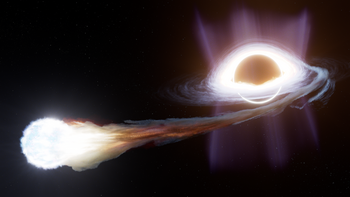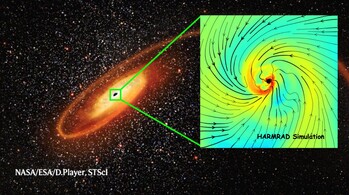
‘As numerical simulations intertwine with astronomical observations, we navigate through the celestial realm where black holes write their stories using light and shadow.’
 Professor Jane Lixin DAI
Professor Jane Lixin DAIAssociate Professor of the Department of Physics
- 2021 NSFC Excellent Young Scientists Fund (Hong Kong & Macau)
- 2019 Sophie and Tycho Brahe Visiting Professorship, Niels Bohr Institute, Denmark
- 2018 Block Award, Aspen Center for Physics
By combining innovative theories with cutting-edge simulations, Dai bridges the gap between abstract mathematics and real-world observations, leading to influential publications in Nature, Nature Astronomy, The Astrophysical Journal, and Space Science Reviews.
‘Black holes are like mirrors of the universe,’ she explains. ‘They reflect its most fundamental forces, but interpreting their reflections requires both imagination and precision.’

A conceptual image illustrating the tidal disruption of a Pop III star and its subsequent feeding of a massive black hole in the early universe. (Image credit: Space Telescope Science Institute/Ralf Crawford)

This simulation visualises the complex interactions between gas, radiation, and magnetic fields near a black hole. By modelling these dynamics under the framework of general relativity, Professor Jane DAI is uncovering new insights into the structure and behavior of black hole accretion disks. (Image credit: NASA/ESA/D.Player,STScl)
Shining a Light on Black Hole
Dai’s model reveals that the apparent dichotomy between X-ray and optical emissions in these events is actually a matter of perspective. ‘It’s like the ancient story of the blind men and the elephant,’ she says. ‘From certain viewing angles, we see X-rays produced as stellar gas falls into the black hole. But from other angles, the accretion “action site” is veiled by winds, where the X-rays are converted to optical light.’
This discovery has provided crucial insights into how black holes grow and release energy, answering fundamental questions about their behaviour and interactions with their surroundings.
Innovations in Astrophysics Calculations
One key focus of her research is X-ray reverberation, a phenomenon that provides a unique observational window into the structure she models. By studying the ‘echoes’ produced when X-rays reflect off accretion disks, Dai is developing methods to probe their inner workings, offering unprecedented insights into black hole parameters and disk structures.
‘This technique allows us to test our theoretical predictions against observational data,’ she explains. ‘It’s a way to connect the simulations we create to what astronomers can actually observe with modern telescopes.’
By bridging the gap between theoretical models and observable phenomena, her work reveals more complex structures, including coronae and wind ejections, representing a significant step forward in our quest to understand these fundamental cosmic structures.
Expanding New Horizons
Looking ahead, she hopes to make a broader impact in black hole astrophysics while continuing to address fundamental questions about the universe. ‘We’re only scratching the surface of what we know about black holes,’ she says. ‘There’s so much more to uncover.
Despite the vastness of the cosmos, Dai’s journey through the stars and black holes promises to be filled with impactful discoveries and cutting-edge research in astrophysics.
| < Previous | Next > |

